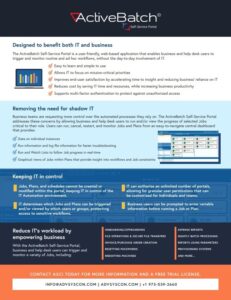Self-Service Automation – A Boon for Business and IT
Self-service automation saves IT time and improves service levels by enabling business and help desk users to run workflows without IT. Learn more here --

Back in 2020, Gartner estimates that 75% of IT organizations will provide self-service capabilities to business users by 2021. Now the self-service IT landscape is advancing, granting end users the capability to address an expanded array of IT issues independently, minimizing the necessity for direct IT intervention. What can you automate with self-service IT?
What is Self-Service Automation?
Self-service automation tools enable business users and help desk teams to run automated jobs or processes that IT has traditionally been responsible for.
Self-service automation is provided through a workload automation or enterprise scheduler that connects to both business and IT systems. This gives users the ability to:
- Execute file transfers
- Run BI reports
- Kick-off onboarding processes
- Provision resources
- Run batch processes
- Reset passwords
- Reboot virtual machines
- And much more
Self-service automation solutions are typically web-based applications with intuitive user interfaces that allow users to not only trigger business processes, but to cancel and restart those jobs as well. Self-service automation applications also provide monitoring so users can follow job progress in real time.
Here’s Why Self-Service is so Important
“IT key metrics data show that, each year, IT service desks are dealing with increased numbers of interactions but provided with fewer resources, making it difficult to keep pace with the requirements of digital business.”
-Gartner, 3 Simple Ways IT Service Desks Should Handle Incidents and Requests
IT departments, including service desk teams, are busier than they’ve ever been. The culprit is a proliferation of data, processes, and digital tools and systems necessary for day-to-day business. Yet even with more to manage, most IT budgets remain anemic, with IT teams pressed for time and resources.
In order for IT to maintain SLAs while supporting digital transformation goals, IT personnel must reduce the time spent performing manual, repetitive tasks. Self-service technology can play a key role in achieving this by reducing the number routine business requests IT needs to respond to.
Likewise, as organizations become more digital-minded, day-to-day business operations are becoming increasingly reliant on IT services. However, as we just noted, IT doesn’t have the capacity to efficiently meet increased business demands.
As a result, business teams are left on hold, waiting for IT to reset passwords or to run reports, slowing down the pace of business. By providing self-service automation to business partners, delays can be avoided, customer service can be improved, and IT’s workload can be reduced.
What Are The Benefits of Self-Service?
IT departments, including service desk teams, are busier than they’ve ever been. The culprit is a proliferation of data, processes, and digital tools and systems necessary for day-to-day business. Yet even with more to manage, most IT budgets remain anemic, with IT teams pressed for time and resources.
In order for IT to maintain SLAs while supporting digital transformation goals, IT personnel must reduce the time spent performing manual, repetitive tasks. Self-service technology can play a key role in achieving this by reducing the number routine business requests IT needs to respond to.
Likewise, as organizations become more digital-minded, day-to-day business operations are becoming increasingly reliant on IT services. However, as we just noted, IT doesn’t have the capacity to efficiently meet increased business demands.
As a result, business teams are left on hold, waiting for IT to reset passwords or to run reports, slowing down the pace of business. By providing self-service automation to business partners, delays can be avoided, customer service can be improved, and IT’s workload can be reduced.
What Are The Benefits of Self-Service?
On average, 16% of service desk tickets are for password resets, with an average cost of $15.11 for every service desk ticket handled.1
With self-service automation tools, IT can reduce the burden of routine business requests, improving service levels. On the business side, end-users have faster access to critical data and processes. They can reset their own passwords when they receive expiration notifications, and, with self-service tools that provide monitoring, can receive notifications if and when a BI report is delayed, and can restart the job if necessary.
Self-service automation can be used to:
- Reduce operating costs
- Reserve resources
- Streamline service management
- Reduce friction between IT and business teams
- Improve time to insight
- Increase productivity
IT Spending Too Much Time On Service Tickets?
Enable business users to trigger and monitor routine workflows without submitting IT tickets.
Self-Service Automation Examples
Self-service automation tools provided through a workload automation or enterprise scheduling platform can typically connect to any application or system in the organization, so long as IT has these connections set up. This makes for a potentially endless list of use cases for self-service automation.
- Sub-Zero, a global manufacturer, uses a self-service portal to send emails to business personnel whenever a critical job fails or is delayed. Those business users can then quickly troubleshoot and restart those jobs as needed, saving “many hours of time each month.” [Read the full case study]
- The Children’s Hospital & Medical Center of Omaha has enabled its patient accounting department to run end-of-month reports using self-service automation.
- SBA Communications uses self-service automation to give non-IT users access to a service catalog of jobs and processes. For security, IT admins applied role-based permissions to each of the available jobs. This allows the accounting department to run processes and reports without having to involve IT. [Read the full case study]
- At SThree, the IT department has automated the provisioning of mobile devices using a self-service process, enabling greater flexibility that’s had a marked effect on customer experience for their bring-your-own-device campaign.
Security and Compliance
Self-service automation portals are designed to give business users customized access to the tasks and processes their day-to-day jobs depend on.
In other words, IT stays in control –it is up to IT to provide user permissions for teams and individuals, protecting access to sensitive workflows and systems. Most self-service portals do not support the development of automated processes so that non-IT personnel cannot create or modify processes.
Additionally, self-service automation reduces pressure for business teams to find shadow-IT workarounds. Tired of waiting on IT tickets, business teams tend to find other ways to meet their needs such as installing applications or solutions without IT’s knowledge or consent. Self-service automation provides a third option that enforces compliance with comprehensive auditing and control.
Self-Service Best Practices
Providing self-service solutions can be a bit like bringing a horse to water –you can offer it, but you can’t always get people to use it.
Following a few best practices when implementing a self-service automation portal can help your team reduce IT tickets faster while providing a service that business teams are excited to use (because they know it will make their lives easier).
- Solicit feedback from business users to learn more about what they would want to accomplish with a self-service tool. Use surveys or focus groups to determine what processes would provide the business the most benefit.
- Take a look at the most common service requests received by ITSM or service desk teams. Routine, manual processes offer a good opportunity to use self-service to reduce the volume of requests IT must respond to.
- Get buy-in from business teams by collaborating with business leaders and communicating the benefits that self-service automation can provide to their teams. Build awareness of the self-service portal by highlighting success stories and working with business partners to develop internal messaging.
- Create an internal launch plan for your self-service automation portal and encourage business users to submit enhancement requests as well as provide feedback on existing options.
Self-service automation is designed to lessen IT’s workload by giving business teams the tools they need to work faster, smarter, and more efficiently. It’s a win-win for everyone.
1 Gartner, Design IT Self-Service for the Business Consumer, Oct. 2017. https://www.gartner.com/document/3812165
Ready to simplify your data warehousing with workload automation?
Schedule a demo to watch our experts run jobs that match your business requirements in ActiveBatch. Get your questions answered and learn how easy it is to build and maintain your jobs.








